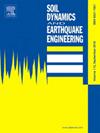Effective height based interaction surface approach for the seismic design of shallow foundations resting on homogeneous slopes
IF 4.2
2区 工程技术
Q1 ENGINEERING, GEOLOGICAL
引用次数: 0
Abstract
Despite being seismically vulnerable, foundations on slopes continue to be designed using the bearing capacity equation meant for shallow foundations resting on flat ground. While some bridge design specifications specify reduction factors for the estimation of bearing capacity of shallow foundations on slopes, the loading condition assumed in arriving at these reduction factors is not consistent with the actual field conditions. The present study highlights the limitations of the current code-based approaches for the seismic design of shallow foundations resting on slopes. Triaxial (V-Hx-Hy) seismic capacity surfaces are developed by performing three-dimensional finite element limit analyses, using pseudo-static approach, on surface and embedded square footings resting on dry and homogeneous sandy slopes, using Optum G3. The relationship between the horizontal force and the moment acting on a foundation, governed by the effective height of the supported column, is considered in developing the capacity surfaces. The vertical load capacity of a foundation on a slope is significantly lower than that of a similar foundation on flat ground. Additionally, the difference in horizontal capacities in the down-slope and up-slope directions increases with the axial load level. Foundation embedment significantly enhances both vertical and horizontal load capacities. A foundation located at the minimum edge distance from the slope face has a much higher vertical load capacity than a surface foundation placed at the crest. Failure mechanisms governed by horizontal load result in lower foundation capacity compared to those governed by moment. The seismic coefficient in the down-slope direction negatively affects foundation capacity.
基于有效高度相互作用面的同质斜坡浅基础抗震设计方法
尽管斜坡上的地基易受地震影响,但在设计时仍采用了针对平地浅层地基的承载力公式。虽然一些桥梁设计规范规定了用于估算斜坡上浅层地基承载力的折减系数,但得出这些折减系数时所假设的荷载条件与实际现场条件并不一致。本研究强调了目前基于规范的斜坡浅基础抗震设计方法的局限性。通过使用 Optum G3,采用伪静力法对位于干燥和均质砂质斜坡上的表面和嵌入式方形基底进行三维有限元极限分析,开发了三轴(V-Hx-Hy)地震承载力曲面。在绘制承载力曲面时,考虑了作用在地基上的水平力和力矩之间的关系,该关系受支撑柱有效高度的制约。斜坡上地基的垂直承载能力明显低于平地上类似地基的垂直承载能力。此外,斜坡下方向和斜坡上方向的水平承载力差异随着轴向荷载水平的增加而增大。地基嵌入可大大提高垂直和水平承载能力。位于斜坡面最小边缘距离的地基比位于坡顶的地基具有更高的垂直承载能力。受水平荷载作用的破坏机制导致地基承载力低于受力矩作用的破坏机制。下坡方向的地震系数对地基承载力有负面影响。
本文章由计算机程序翻译,如有差异,请以英文原文为准。
求助全文
约1分钟内获得全文
求助全文
来源期刊

Soil Dynamics and Earthquake Engineering
工程技术-地球科学综合
CiteScore
7.50
自引率
15.00%
发文量
446
审稿时长
8 months
期刊介绍:
The journal aims to encourage and enhance the role of mechanics and other disciplines as they relate to earthquake engineering by providing opportunities for the publication of the work of applied mathematicians, engineers and other applied scientists involved in solving problems closely related to the field of earthquake engineering and geotechnical earthquake engineering.
Emphasis is placed on new concepts and techniques, but case histories will also be published if they enhance the presentation and understanding of new technical concepts.
 求助内容:
求助内容: 应助结果提醒方式:
应助结果提醒方式:


